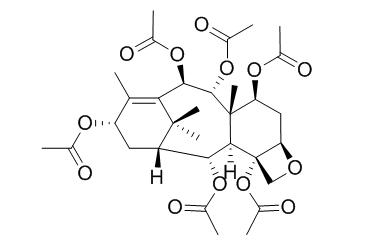1-Dehydroxybaccatin IV
1-Dehydroxybaccatin IV is a natural product from Taxus mairei.
Inquire / Order:
manager@chemfaces.com
Technical Inquiries:
service@chemfaces.com
Tel:
+86-27-84237783
Fax:
+86-27-84254680
Address:
1 Building, No. 83, CheCheng Rd., Wuhan Economic and Technological Development Zone, Wuhan, Hubei 430056, PRC
Providing storage is as stated on the product vial and the vial is kept tightly sealed, the product can be stored for up to
24 months(2-8C).
Wherever possible, you should prepare and use solutions on the same day. However, if you need to make up stock solutions in advance, we recommend that you store the solution as aliquots in tightly sealed vials at -20C. Generally, these will be useable for up to two weeks. Before use, and prior to opening the vial we recommend that you allow your product to equilibrate to room temperature for at least 1 hour.
Need more advice on solubility, usage and handling? Please email to: service@chemfaces.com
The packaging of the product may have turned upside down during transportation, resulting in the natural compounds adhering to the neck or cap of the vial. take the vial out of its packaging and gently shake to let the compounds fall to the bottom of the vial. for liquid products, centrifuge at 200-500 RPM to gather the liquid at the bottom of the vial. try to avoid loss or contamination during handling.
Int J Mol Sci.2024, 25(18):10219.
Nutrients.2020, 12(12):3607.
Molecules.2024, 29(5):1050.
Food Chem Toxicol.2024, 186:114589.
Korean J Dent Mater.2018, 45(2):139-146
Inflammation.2020, 43(5):1716-1728.
Pharmacol Rep.2022, 74(1):175-188.
Eur J Pharmacol.2021, 906:174220.
Chinese Journal of Tissue Engineering Research2024, 28(8):1149-1154.
Appl. Sci.2023, 13(17), 9653.
Related and Featured Products
Yao Xue Xue Bao. 1989;24(9):673-7.
Studies on the taxane diterpenes of the heartwood from Taxus mairei.[Pubmed:
2618716]
A new taxane diterpene and three known taxane diterpenes were isolated from the heartwood of Taxus mairei grown in Fujian province of China and identified as 1-dehydroxy-baccatin VI, baccatin VI, 1-Dehydroxybaccatin IV, and taxinne J on the basis of spectral data.



